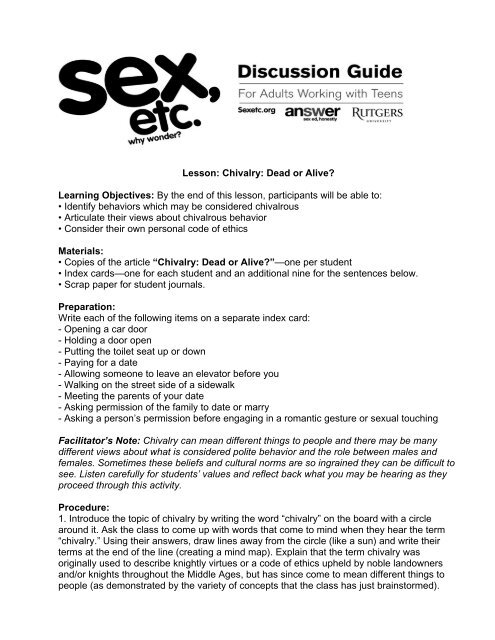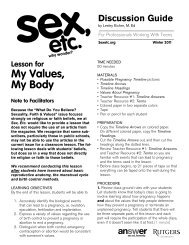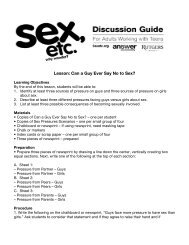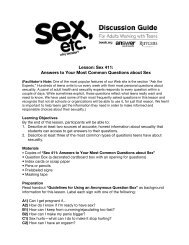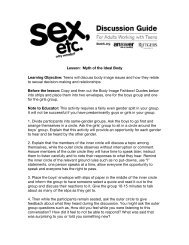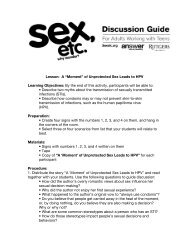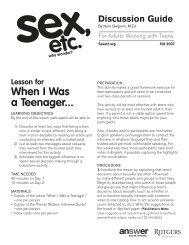Lesson: Chivalry: Dead or Alive? Learning Objectives: By ... - Answer
Lesson: Chivalry: Dead or Alive? Learning Objectives: By ... - Answer
Lesson: Chivalry: Dead or Alive? Learning Objectives: By ... - Answer
Create successful ePaper yourself
Turn your PDF publications into a flip-book with our unique Google optimized e-Paper software.
<strong>Lesson</strong>: <strong>Chivalry</strong>: <strong>Dead</strong> <strong>or</strong> <strong>Alive</strong>?<br />
<strong>Learning</strong> <strong>Objectives</strong>: <strong>By</strong> the end of this lesson, participants will be able to:<br />
• Identify behavi<strong>or</strong>s which may be considered chivalrous<br />
• Articulate their views about chivalrous behavi<strong>or</strong><br />
• Consider their own personal code of ethics<br />
Materials:<br />
• Copies of the article “<strong>Chivalry</strong>: <strong>Dead</strong> <strong>or</strong> <strong>Alive</strong>?”—one per student<br />
• Index cards—one f<strong>or</strong> each student and an additional nine f<strong>or</strong> the sentences below.<br />
• Scrap paper f<strong>or</strong> student journals.<br />
Preparation:<br />
Write each of the following items on a separate index card:<br />
- Opening a car do<strong>or</strong><br />
- Holding a do<strong>or</strong> open<br />
- Putting the toilet seat up <strong>or</strong> down<br />
- Paying f<strong>or</strong> a date<br />
- Allowing someone to leave an elevat<strong>or</strong> bef<strong>or</strong>e you<br />
- Walking on the street side of a sidewalk<br />
- Meeting the parents of your date<br />
- Asking permission of the family to date <strong>or</strong> marry<br />
- Asking a person’s permission bef<strong>or</strong>e engaging in a romantic gesture <strong>or</strong> sexual touching<br />
Facilitat<strong>or</strong>’s Note: <strong>Chivalry</strong> can mean different things to people and there may be many<br />
different views about what is considered polite behavi<strong>or</strong> and the role between males and<br />
females. Sometimes these beliefs and cultural n<strong>or</strong>ms are so ingrained they can be difficult to<br />
see. Listen carefully f<strong>or</strong> students’ values and reflect back what you may be hearing as they<br />
proceed through this activity.<br />
Procedure:<br />
1. Introduce the topic of chivalry by writing the w<strong>or</strong>d “chivalry” on the board with a circle<br />
around it. Ask the class to come up with w<strong>or</strong>ds that come to mind when they hear the term<br />
“chivalry.” Using their answers, draw lines away from the circle (like a sun) and write their<br />
terms at the end of the line (creating a mind map). Explain that the term chivalry was<br />
<strong>or</strong>iginally used to describe knightly virtues <strong>or</strong> a code of ethics upheld by noble landowners<br />
and/<strong>or</strong> knights throughout the Middle Ages, but has since come to mean different things to<br />
people (as demonstrated by the variety of concepts that the class has just brainst<strong>or</strong>med).
2. Distribute copies of the article “<strong>Chivalry</strong>: <strong>Dead</strong> <strong>or</strong> <strong>Alive</strong>?” and read it together with your<br />
students.<br />
3. Ask the class, “who decides what is chivalrous?” and “where did you learn what was<br />
chivalrous?”<br />
4. Pass out index cards to students. Explain that you are going to ask them to write down one<br />
behavi<strong>or</strong> that they would consider chivalrous. You can offer examples from the list of index<br />
cards you have prepared.<br />
5. Have students turn in their cards, then mix them up and redistribute them to the class<br />
along with the index cards you prepared, so that some students will get m<strong>or</strong>e than one. Have<br />
them write on their card whether the behavi<strong>or</strong> on is an example of chivalry <strong>or</strong> not.<br />
6. Lead a class discussion about their cards. With a show of hands, ask, “how many people<br />
are holding a card they consider to be chivalrous?” Then ask those people what behavi<strong>or</strong>s<br />
they have and why they believe them to be chivalrous <strong>or</strong> not. Ask f<strong>or</strong> opinions that may<br />
disagree <strong>or</strong> differ in perspective. Then ask f<strong>or</strong> a show of hands from people who are holding<br />
a card they do not find to be chivalrous. What are those behavi<strong>or</strong>s? Ask students don’t<br />
believe them to be chivalrous.<br />
7. Follow up with a few questions f<strong>or</strong> class discussion:<br />
• <strong>Chivalry</strong> seems to run along gender (male/female) lines, with males doing things f<strong>or</strong><br />
females. What do you think about this aspect of chivalry?<br />
Should chivalry go both ways? If so, why?<br />
• Do you think chivalry is dead? Why <strong>or</strong> why not?<br />
8. Read Webster's Dictionary definition:<br />
<strong>Chivalry</strong>:<br />
1. Gallantry, courtesy and hon<strong>or</strong>.<br />
2. The noble qualities a knight was supposed to have, such as courage and a readiness to<br />
help the weak.<br />
3. The demonstration of any of these qualities.<br />
4. Explain that some might say chivalry is a choice. The choice to do the right things, f<strong>or</strong> the<br />
right reasons, at the right times. Ask students to consider what their own personal code of<br />
ethics would look like. Have them consider three principles they would want to live their life<br />
by (such as to be honest, demonstrate integrity, protect the weak, etc.) Have students write<br />
these down.<br />
5. To encourage further reflection, have students journal ways that they have and can<br />
continue to demonstrate that code. So, f<strong>or</strong> example, if one of their principles is to live by the<br />
code of hon<strong>or</strong>—what would hon<strong>or</strong>able conduct look like? What behavi<strong>or</strong>s are hon<strong>or</strong>able and<br />
dishon<strong>or</strong>able? Spend the last bit of class time having students write down their thoughts<br />
about their code of principles.
Facilitat<strong>or</strong>’s Resource:<br />
Scenarios USA is a non-profit <strong>or</strong>ganization that is dedicated to giving young people a<br />
creative f<strong>or</strong>um to expl<strong>or</strong>e and express who they are and how they see the w<strong>or</strong>ld, with the<br />
goal of helping them make healthy decisions about their lives. Teens, aged 12-22, address<br />
issues such as HIV/AIDS, unplanned pregnancy and violence by writing st<strong>or</strong>ies f<strong>or</strong> the<br />
annual "What's the REAL Deal?" contest. The winners are partnered with professional<br />
filmmakers and crew, who help them produce their st<strong>or</strong>ies into high-quality sh<strong>or</strong>t films in their<br />
hometown. These sh<strong>or</strong>t but powerful videos will help trigger classroom conversation about<br />
topics affecting teenagers, lives. You can view film clips by going to:<br />
www.scenariosusa.<strong>or</strong>g/movies. They are available to <strong>or</strong>der online.<br />
The Discussion Guide was created by Teri Tomatich, M.Ed., professional trainer/consultant.<br />
F<strong>or</strong> additional lessons, go to http://answer.rutgers.edu/page/lesson_plans.<br />
Copyright © <strong>Answer</strong>, Rutgers University. All Rights Reserved.


